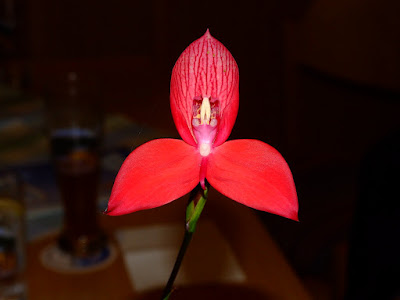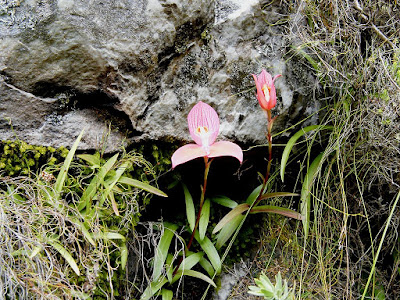Disa uniflora is native to South Africa. This terrestrial orchid is often found along streams, near waterfalls and in areas that drain away along cliffs, near Cape Town and in the southwestern Cape Province...
Disa uniflora also called as The Single Flowered Disa, Red Disa, The pride of Table Mountain, Disa barelli, Disa grandiflora, Satyrium grandiflorum, is a species of the genus Disa. This species was described by Peter Jonas Bergius in 1767.
IDENTIFY DISA UNIFLORA
Disa uniflora is native to South Africa. This terrestrial orchid is often found along streams, near waterfalls and in areas that drain away along cliffs, near Cape Town and in the southwestern Cape Province. They always appear where there is constantly flowing water, grow in peat black, in deep sand or in moss with streams and in rock hollows with roots well fixed in flowing water. Along the streams, they form dense colonies located above the water level in the middle of summer, while at higher water levels during winter rains they can be completely submerged in water. They grow in acidic soil at pH 5-6 and do not tolerate water with a salt concentration above 200 parts per million. They are most often found growing in full sun, but they can also grow in conditions from total shade to full sun.
It is a small to medium sized, cool to cold growing terrestrial orchid, which reaching 15-60 cm tall, with stout leafy, over 60 cm in length stems with lanceolate to elongate-lanceolate, acute, spreading, 15-25 cm long leaves.
The Single Flowered Disa blooms in the fall through spring on a 20 to 30 cm long, raceme with lanceolate, acuminate bracts and 1 to 3 flowers, occasionally more, occurring through the summer. The flowers are 8-12 cm in diameter. The most common color of flowers is the carmine-red color, but the color is variable and there are clones with pink or orange flowers, as well as plants with yellow flowers, although these are very rare. In addition, clones with orange or red lateral flakes of the outer whorl and white or yellow ridge petals with dark red venation are known.
DISA UNIFLORA CARE AND CULTURE
Cultural information should only be used as a guide, and should be to be adapted to suit you. Your physical location; where you grow your plants, how much time you have to devote to their care, and many other factors, will need to be taken into account. Only then can you decide on the cultural methods that best suit you and your plants.
Light:
Disa uniflora needs a light level of 20000-50000 lux. These plants usually meet growing in full sun, but they can also grow in conditions from total shade to full sun. The cultivation of these plants may be easier in slightly filtered or diffused light, avoiding the direct midday sun. Those that grow in a relatively bright light usually have better-colored flowers. Strong air movement should be ensured all the time.
Temperature:
It is a plant with moderate thermal requirements. The average temperature in summer is 24-26 ° C and at night 14-15 ° C, which gives a daily difference of 10-11 ° C. In winter the average day temperature is 17-18 ° C, night 7 ° C, with a daily amplitude of 10-11 ° C.
Humidity:
The Single Flowered Disa needs the humidity of 65-70% from spring to early autumn, rising to 75-80% in autumn and winter. You need pay attention to the fact that this plant does not require high humidity.
Substrate, growing media and repotting:
If Disa uniflora are grown hydroponically, they are usually planted in sand on a layer of gravel, and the containers placed in trays partially filled with slowly flowing water. Although hydroponic cultivation belongs rather to the past, some continue to grow these plants in sand and gravel, while others use other inorganic substrates, such as thick perlite or pumice, which are usually covered with a pea-sized gravel layer to prevent leaching them from the pot while watering.
Currently, however, they are usually grown in sphagnum moss or in a mixture of sphagnum moss, fibrous peat and chopped woody fern fibers, sometimes with an admixture of perlite or pumice. Some recommend a mixture of 3 parts peat moss and 1 part perlite. Others grow in pots filled with peat fibers, and the pots are put in a layer of peat. The plants are watered from the top, the peat inside and outside the pot is evenly moist but never standing in the water. The substrate with which it is the easiest to handle, especially if you are a budding breeder, is very loosely packed New Zealand sphagnum moss. Regardless of the substrate used, it should never be packed tightly around the roots, because the air must have excellent access to them, with large free spaces visible after removing the plant from the pot.
The plants should be divided and repotted every year. This is particularly important in the case of plants grown in sphagnum moss, because constant moisture causes the decomposition and fragmentation of this material during the year. In addition, peat moss decay changes the balance of trace elements, which are poisonous for orchids. When the plant initiates a floral shoot in spring, it simultaneously produces new tubers or growths that grow up and bloom the following year. Tubers can be formed at the base of an old increment or at the end of a long runner. New growths emerge after the end of flowering in late spring and early summer, when the growth that gave the flower, turns yellow and begins to die. It is during this period that the plant should be divided and replanted when the new growth is still relatively small, the substrate begins to decompose, and the dead tissues of old growth increase the risk of rotting spreading to young growth. An increase that has just finished flowering, together with the tuber and decaying and decomposing roots should be removed, while new growths planted separately to fresh substrate. Mature growth will fit in a 10-12 cm pot. New roots and tubers are very fragile and should be handled gently.
Watering:
From spring to autumn, the precipitation in the natural habitat is small, then going through the rainy season, which lasts from autumn throughout the winter. Disa uniflora should never completely dry out. The availability of water is important, but its quality is critical. High levels of mineral salts and chlorine in average tap water will kill these plants in a short time. In addition, the plants grow best when irrigated with rainwater, but you can also use distilled, deionized or reverse osmosis water. Tap water can be used here and there if the salt concentration is very low and the water does not contain chlorine. As previously stated, the plants naturally grow in acidic conditions, with a pH in the range of 5-6, and do not tolerate water with a salt content of more than 200 parts per million. For some time, the plants were grown in containers standing in water, but it was abandoned because it caused water heating and the spread of diseases.
Fertilizer:
This species will die in fertile soil, so do not use any fertilizers, especially when the plants are grown in sphagnum moss, which provides some nutrients. A layer of living moss, which usually develops on the surface of pots, produces all the nutrients needed by the plant. At most occasionally a very diluted fertilizer solution (20- or 10-fold compared to the recommendations) is used during the active plant growth period and only if they are planted in sand or other inorganic medium.
Rest period:
The Disa uniflora plants consume less water in the winter and lose less by evaporation, so the amount of water can be slightly reduced, but the substrate should always be moist.















COMMENTS